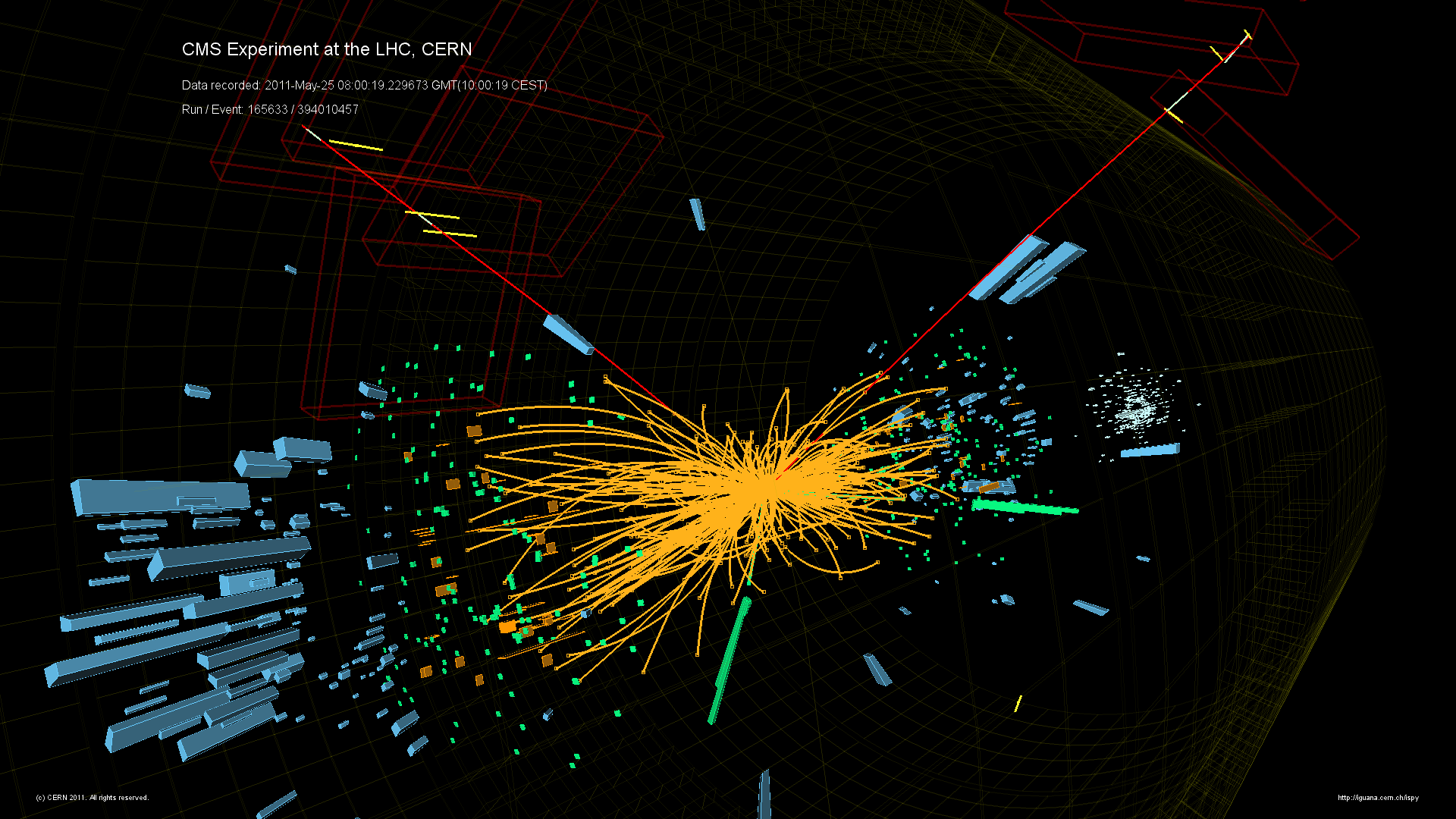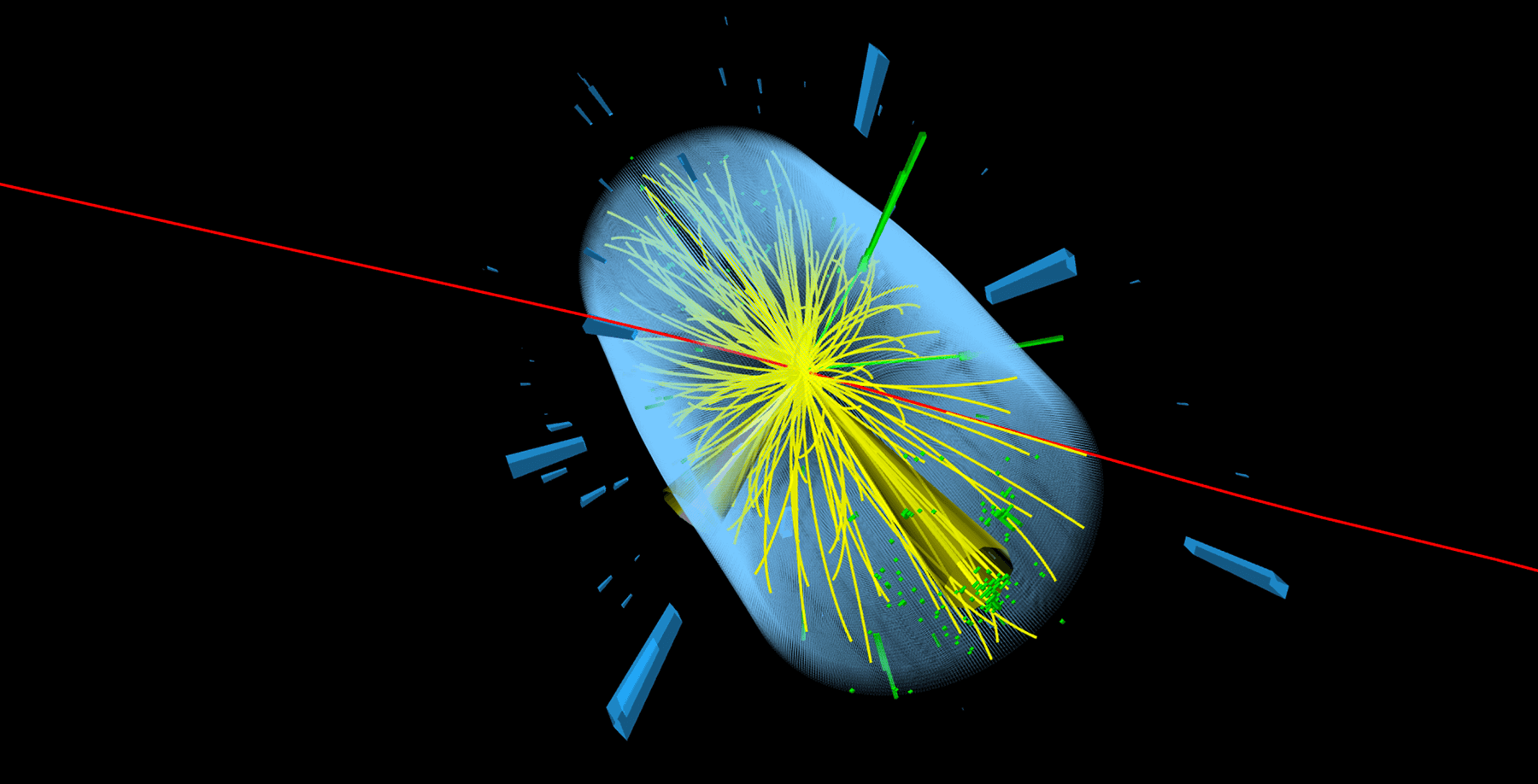
The Higgs boson is the only particle predicted by the Standard Model that has not yet been seen by experiments. It helps explain how elementary particles acquire mass. If the Higgs boson exists it will be produced in proton-proton collisions at the LHC. It then swiftly decays into various known and well-studied particles (depending on the actual Higgs mass). The CMS search for the Higgs boson is being carried out using a range of decay products: two photons; two tau leptons; two b quarks; two W bosons; and two Z bosons. Analysing all these channels ensures that the search is sensitive to observing the Higgs irrespective of its own mass. An example of an event passing the selection criteria is shown in Figure 1, in which two Z bosons are identified through their decays to a pair of electrons and a pair of muons respectively. These results are based on data recorded during LHC running at an energy of 7 TeV in 2010 and 2011. The analysis uses 1.1 – 1.7 inverse femtobarns[1] (integrated luminosity) of data, depending on the channel — an inverse femtobarn corresponds to about 100 trillion proton-proton collisions. CMS observes no convincing excess of events in the explored mass[2] range of 110-600 GeV (for full details see [HIG-11-022]). The analysis excludes, with a confidence level (C.L.) of 95%[3], the existence of a Standard Model Higgs boson in three Higgs mass ranges: 145-216 GeV, 226-288 GeV and 310-400 GeV (Figure 2). For the quantity of data we have collected, on average we would expect to exclude the range 130-440 GeV in the absence of a signal. We believe that the differences between the expected and observed exclusion mass ranges are consistent with statistical fluctuations. At 90% C.L., we exclude the SM Higgs boson in the mass range from 144-440 GeV. All exclusion regions were obtained using the modified frequentist construction confidence levels. It should be noted that a modest excess of events is observed for Higgs boson masses below 145 GeV. With the data we will collect in the coming months we will be able to distinguish between the possible interpretations: the production of a SM Higgs boson or a statistical fluctuation of the backgrounds. During the ongoing LHC proton-proton data-taking period, expected to terminate at the end of 2012, CMS will record substantially more data that should be sensitive to observing a SM Higgs boson, if it exists, over the full range of possible masses.
More information
- All CMS Papers (see also: timeline graphical index of all papers)
- All CMS Physics Analysis Summaries
- All CMS results
About CMS
More information, including images and animations of CMS collision events, may be found on the CMS web site: http://cms.cern.ch. CMS is one of two general-purpose experiments at the LHC that have been built to search for new physics. It is designed to detect a wide range of particles and phenomena produced in the LHC's high-energy proton-proton and heavy-ion collisions and will help to answer questions such as: "What is the Universe really made of and what forces act within it?" and "What gives everything substance?" It will also measure the properties of well-known particles with unprecedented precision and be on the lookout for completely new, unpredicted phenomena. Such research not only increases our understanding of the way the Universe works, but may eventually spark new technologies that change the world in which we live as has often been true in the past. The conceptual design of the CMS experiment dates back to 1992. The construction of the gigantic detector (15 m diameter by nearly 29 m long with a weight of 14000 tonnes) took 16 years of effort from one of the largest international scientific collaborations ever assembled: more than 3100 scientists and engineers from 169 institutions and research laboratories distributed in 39 countries all over the world. For further information, contact: cms.outreach@cern.ch.
- [1] http://news.stanford.edu/news/2004/july21/femtobarn-721.html
http://www.quantumdiaries.org/2011/03/02/why-don%E2%80%99t-we-just-say-collision-rate/ - [2] By mass-energy equivalence, the electron volt is also a unit of mass. It is common in particle physics, where mass and energy are often interchanged, to use eV/c2, where c is the speed of light in a vacuum (from E = mc2). Even more common is to use a system of natural units with c set to 1 (hence, E = m), and simply use eV as a unit of mass. (Source: Wikipedia)
- [3] Confidence level is a statistical measure of the number of times out of 100 that test results can be expected to be within a specified range. For example, a confidence level of 95% means that the result of an action will probably meet expectations 95% of the time. (Source: NADbank)
- Printer-friendly version
- Log in to post comments




